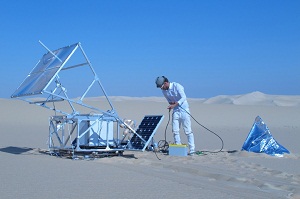3-D printing technology takes to the sun
 3-D printers have existed for a while now. They allow users to “print” a three-dimensional image by depositing plastics or other materials on a flat surface in a pre-programmed design. Many use a laser to sinter—or melt—the material into the appropriate design.
3-D printers have existed for a while now. They allow users to “print” a three-dimensional image by depositing plastics or other materials on a flat surface in a pre-programmed design. Many use a laser to sinter—or melt—the material into the appropriate design.
But Markus Kayser has taken 3-D printing to new level by using the focused heat of the sun to melt sand into glass and fusing it into 3-dimensional pieces with his SolarSinter device.
The device looks like a steroidal magnifying glass attached to a satellite. But with it, Kayser recently was able to create unique forms, including a bowl and a sculpture that looked like a cross between a Mobius strip and sandstone arches.
Here’s a video of the device at work in the Sahara Desert: SolarSinter : markus kayser.
The machine takes advantage of two seemingly endless things in the desert, sun and sand.
“By using the sun’s rays instead of a laser and sand instead of resins, I had the basis of an entirely new solar-powered machine and production process for making glass objects that taps into the abundant supplies of sun and sand to be found in the deserts of the world,” Kayser said.
The device concentrates the sunlight into a beam about 1 centimeter in diameter, Kayser said.
The focused energy is enough to burn or sinter the sand into glass.
“I never measured the temperature but to melt sand, it must be between 1,400 to 1,600 degrees celsius,” he said.
Kayser got the idea for the SolarSinter when testing out another solar-powered device he invented called the SunCutter.
“It started when I was in the desert with the SunCutter. I thought, ‘Why am I bringing material to the desert when its full of it?’ Energy and material in abundance, I thought I could create a 'translator' which would combine the energy and material to produce objects,” he said.
The SolarSinter was tested in May this year, according to Kayser.
“I will develop the machine further as these are the first experiments,” he said. “At the moment, I am seeking funding to continue with this machine but also [working] in collaboration with architects, scientists and engineers, as well as programmers to develop this process in as many directions as possible. This is a point of departure.”
Image courtesy of Markus Kayser.



